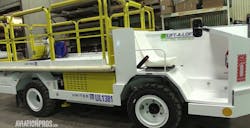Aug. 31--The nation's outdated and unreliable air-traffic system took its first step toward modernization with the award of a $1.8 billion contract on Thursday.
The Federal Aviation Administration awarded the first piece of a $15 billion airspace makeover to ITT Corp., whose partners include San Antonio-based AT&T Corp. The contractors will develop a satellite-based navigation system that promises to be 10 times more accurate than ground-based radar -- allowing air-traffic controllers to pinpoint the position of jets and thus fit more into the sky.
The air-traffic system has been one culprit in the growing number of flight delays this year. Because ground-based radar is not precise enough, controllers compensate by adding more space between jets.
Although the transition to a satellite-based system will take nearly 20 years, Robert A. Sturgell, the FAA's deputy administrator, said Thursday that, "for passengers, the endgame is fewer delays."
"In just a few years, our aviation system is going to change dramatically," Mr. Sturgell said.
Some air traffic controllers insist the FAA is over-promising. They said the new system would not allow airlines to conquer bad weather and would not address the capacity problems at many East Coast airports, such as New York's LaGuardia Airport. Many of those airports are shoehorned into tight quarters and do not have room to build new runways.
At Dallas/Fort Worth International Airport, weather has been the cause of most delays and cancellations this summer. The percentage of late arrivals at D/FW in June was at a 20-year record.
"It does not solve the problem of thunderstorms getting in the way of going to a major airport or airlines that have overscheduled at the busiest periods of the day," said Doug Church, a spokesman for the National Air Traffic Controllers Association.
The system could prove helpful to controllers at D/FW, which has more runways than many other major airports and thus could absorb more flights, said Ric Loewen, the local president of the Air Traffic Controllers Association at D/FW Tower. But while D/FW could handle more operations, problems in other parts of the country might not allow it, he said.
"A lot of what affects system-wide capacity is there are, throughout the system, a number of chokepoints," Mr. Loewen said.
To win the contract to develop a surveillance system known as ADS-B, ITT beat out Lockheed Martin Corp. and Raytheon. ITT will receive $207 million for the first three years of the contract, when the system is deployed and tested.
ADS-B relies on satellites to relay the exact position of an airplane to its cockpit, similar to global-positioning system devices that are found in many new cars.
Planes will beam that data and information about speed and altitude to about 300 ground stations. AT&T's cell towers will provide some of those stations, as will oil platforms in the Gulf of Mexico, officials said.
The ground stations, which must be operational by 2013, will send the information to air traffic controllers, who will communicate with the pilots.
The satellite network will communicate a jet's position to the cockpit about every second. Radar provides data every 3 to 12 seconds, forcing controllers to add extra space between planes to guard against midair accidents.
Congress is scheduled to debate next month how to pay for ADS-B and the rest of the next-generation air-traffic system.
To see more of The Dallas Morning News, or to subscribe to the newspaper, go to http://www.dallasnews.com. Copyright (c) 2007, The Dallas Morning News Distributed by McClatchy-Tribune Information Services. For reprints, email [email protected], call 800-374-7985 or 847-635-6550, send a fax to 847-635-6968, or write to The Permissions Group Inc., 1247 Milwaukee Ave., Suite 303, Glenview, IL 60025, USA.





